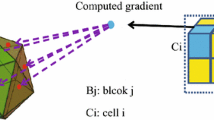Abstract
In order for robots to effectively interact with people in close proximity, the systems must first be able to detect, track, and follow people. This paper describes results from the development of a mobile robot which will follow a single, unmarked pedestrian using vision. This work demonstrates an improvement over existing pedestrian following applications because (1) it uses sufficiently strong classifiers such that it does not need to adapt to any particular pedestrian, (2) uses only vision and does not rely on any laser range devices, (3) provides a single point benchmark for the level of performance required from a detector to achieve pedestrian following, and (4) its performance is characterized over several kilometers in both rainy and dry weather conditions. The system leverages Histograms of Oriented Gradients (HOG) features for pedestrian detection at over 8 Hz using video from a monochrome camera. The pedestrian’s heading is combined with distance from stereo depth data to yield a 3D estimate. A particle filter with some clutter rejection provides a continuous track, and a waypoint follow behavior servos the iRobot PackBot robot chassis to a desired location behind the pedestrian. The final system is able to detect, track, and follow a pedestrian over several kilometers in outdoor environments, demonstrating a level of performance not previously shown on a small unmanned ground vehicle.
Similar content being viewed by others
References
Satake J, Miura J (2009) Robust stereo-based person detection and tracking for a person following robot. In: Proceedings of the IEEE ICRA 2009 workshop on people detection and tracking
Loper M, Koenig N, Chernova S, Jenkins C, Jones C (2009) Mobile human-robot teaming with environmental tolerance. In: Proceedings of the ACM/IEEE international conference on human-robot interaction, pp 157–164
Kwon H, Yoon Y, Park J, Kak A (2005) Person tracking with a mobile robot using two uncalibrated independently moving cameras. In: Proceedings of IEEE international conference on robotics and automation
Kleinehagenbrock M, Lang S, Fritsch J, Lomker F, Fink G, Sagerer G (2002) Person tracking with a mobile robot based on multi-modal anchoring. In: Proceedings of IEEE international workshop on robot and human interactive communication, pp 423–429
Yoshimi T, Nishiyama M, Sonoura T, Nakamoto H, Tokura S, et al (2006) Development of a person following robot with vision based target detection. In: Proceedings of IEEE/RSJ international conference on intelligent robots and systems
Shaker S, Saade J, Asmar D (2008) Fuzzy inference-based person-following robot. Int J Syst Appl Eng Dev 2(1)
Kirby R, Forlizzi J, Simmons R (2007) Natural person-following behavior for social robots. In: Proceedings of the ACM/IEEE international conference on human-robot interaction, pp 17–24
Topp E, Christensen H (2005) Tracking for following and passing persons. In: Proceedings of the IEEE/RSJ international conference on intelligent robots and systems, pp 70–76
Schlegel C, Illmann J, Jaberg K, Schuster M, Worz R (1998) Vision based person tracking with a mobile robot. In: Proceedings of the ninth British machine vision conference, pp 418–427
Tarokh M, Kuo J (2006) Vision based person tracking and following in unstructured environments. In: Proceedings of IEEE 13th annual conf on mechatronics and machine vision in practice, vol 1, pp 031.1–031.6
Zhu Q, Yeh M, Cheng K, Avidan S (2006) Fast human detection using a cascade of histograms of oriented gradients. In: IEEE computer society conference on computer vision and pattern recognition, vol 2, no 2, pp 1491–1498
Dalal N (2006) Finding people in images and videos. Dissertation, Institut National Polytechnique de Grenoble
Dalal N, Triggs B (2005) Histograms of oriented gradients for human detection. In: Proceedings of IEEE conference computer vision and pattern recognition, pp 886–893
Ess A, Leibe B, Schindler K, van Gool L (2008) A mobile vision system for robust multi-person tracking. In: Proceedings of IEEE conference on computer vision and pattern recognition
Lau B, Arras K, Burgard W (2009) Multi-model hypothesis group tracking and group size estimation. In: Proceedings of the IEEE ICRA 2009 workshop on people detection and tracking
Sullivan J, Nillius P, Carlsson S (2009) Multi-target tracking on a large scale: experiences from football player tracking. In: Proceedings of the IEEE ICRA 2009 workshop on people detection and tracking
Viola P, Jones M (2001) Rapid object detection using a boosted cascade of simple features. In: Proceedings of IEEE conference on computer vision and pattern recognition, vol 1, pp 511
Needham C, Boyle R (2003) Performance evaluation metrics and statistics for positional tracker evaluation. In: Proceedings of international conference on computer vision systems, pp 278–289
Särkkä S, Vehtari A, Lampinen J (2007) Rao-Blackwellized particle filter for multiple target tracking. Inf Fusion J 8(1):2–15
Schapire R (2001) The boosting approach to machine learning: an overview. In: MSRI workshop on nonlinear estimation and classification
National Oceanic and Atmospheric Administration (2009) Current weather conditions: Bedford Hanscom Field, MA, United States. http://weather.noaa.gov/weather/current/KBED.html. Accessed 21 July 2009
iRobot research videos. http://www.irobot.com/sp.cfm?pageid=189. “iRobot Tactical Teams/Natural HRI”
Author information
Authors and Affiliations
Corresponding author
Rights and permissions
About this article
Cite this article
Brookshire, J. Person Following Using Histograms of Oriented Gradients. Int J of Soc Robotics 2, 137–146 (2010). https://doi.org/10.1007/s12369-010-0046-y
Accepted:
Published:
Issue Date:
DOI: https://doi.org/10.1007/s12369-010-0046-y




